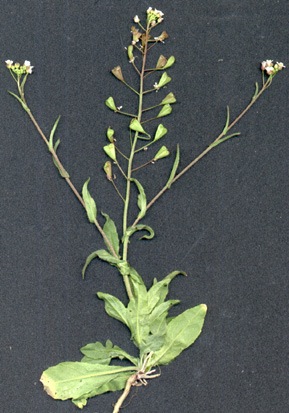
|

|
| Shepherd's Purse; Capsella Bursa-pastoris (L.) Medic. |
Mustard Family; CRUCIFERÆ (BRASSICACEÆ)
|
| Shepherd's Purse is a slender, lithe, annual herb, usually knee-high or less. It grows in varied habitats: part shade to full sun, any
quality of soil, but best on disturbed, rich loam such as garden vegetables prefer, and on bark mulches. On poor ground, it is often small,
stringy and scrawny. In any case, as with Chickweed, its flowers can be found nearly every month of the year, somewhere. They're tiny,
white, inconspicuous, and give rise to unmistakable flat,
triangular 1/4 to
1/3 inch seedpods. Hence the names: Shepherd's Purse,
Caseweed, Witches' Pouches, Pick-Pocket, Mother's Heart, and so forth. As stripes mark zebras, as acorns make an oak, so these triangular
seedpods characterize Shepherd's Purse. |
| Also called "Poor Man's Pharmacetie," it's a country cure for various minor ills in the Old World, whence it originated
before becoming a global weed. The main medicinal attributes are: diuretic, stimulant, antiscorbutic, hæmostaic, and astringent. It is one of
the "Seven herbs of spring" in Japan, gathered on the seventh day of the new year. |
It is edible, raw or cooked, from tiny taproot to tender tip. Shepherd's Purse is higher in protein than most edible weeds.
Abundant, anyone may harvest it.
|
Originally published as the Seattle Tilth newsletter Weed of the Month in January 1986, along with an illustration drawn by Jerri Geer.
Back |
|
|

